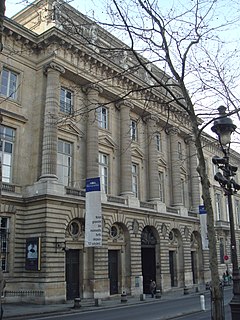
The Monnaie de Paris is a government-owned institution responsible for producing France's coins. Founded in AD 864 with the Edict of Pistres, it is the world's oldest continuously running minting institution.

The Archdiocese of Munich and Freising is an ecclesiastical territory or diocese of the Roman Catholic Church in Bavaria, Germany. It is governed by the Archbishop of Munich and Freising, who administers the see from the co-cathedral in Munich, the Frauenkirche, which is never called in German Munich Cathedral. The other, much older co-cathedral is Freising Cathedral.

The former Moscow City Hall is an ornate red-brick edifice situated immediately to the east of the State Historical Museum and notable in the history of architecture as a unique hybrid of the Russian Revival and Neo-Renaissance styles. During Soviet times it served as the V. I. Lenin Museum.

The Cuvilliés Theatre or Old Residence Theatre is the former court theatre of the Residenz in Munich, Bavaria, Germany.
The Alter Hof in the center of Munich is the former imperial residence of Louis IV, Holy Roman Emperor and consists of five wings: Burgstock, Zwingerstock, Lorenzistock, Pfisterstock and Brunnenstock. Like most of the old town, it was rebuilt after being destroyed in World War II. Hitler painted it once.

The ruins of Falkenstein Castle is in the Weinviertel region of Lower Austria, about 55 kilometres (34 mi) north of Vienna near the border to Czech Republic.

The Residence Theatre or New Residence Theatre of the Residence in Munich was built from 1950 to 1951 by Karl Hocheder. The renovation of 1981 by Alexander von Branca removed the decoration which had been done in the typical style of the early 1950s.
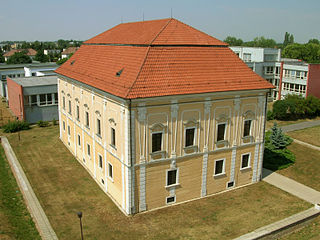
The Esterházy of Galanta castle is a renaissance castle. It is one of the most important historical buildings of Galanta, Slovakia. Originally, the residency of the Esterházy family, a branch called the Esterházy "of Galanta". it was built and inhabited by the Esterházy of Galanta family since around 1630, when it was built. It is still in renovation nowadays, and hopefully, will one day serve as a part of the regional museum in Slovakia. Its ground floor is a Restaurant and serves as a place for holding wedding ceremonies and for bigger representational activities, the basement is a hip BAR, and hosts cultural and social activities, and the first floor will in the near future serve as a gallery and for museum purposes.

The Maximilianstraße in Munich is one of the city's four royal avenues next to the Brienner Straße, the Ludwigstraße and the Prinzregentenstraße. It starts at Max-Joseph-Platz, where the Residenz and the National Theatre are situated, and runs east-west. Planned and begun in 1850 by King Maximilian II of Bavaria, the street takes his name. The lead architect was Friedrich Bürklein. Today, Maximilianstraße has the distinction of the highest retail rents in Germany.

The Ljubljana Opera House is an opera house in Ljubljana, the capital of Slovenia. The seat of the national opera and ballet company, the Ljubljana Slovene National Theatre Opera and Ballet, it serves as the national opera building of the country. It stands at 1 Župančič Street between the Slovenian Parliament building, on one hand, and the National Museum and the National Gallery, on the other hand.
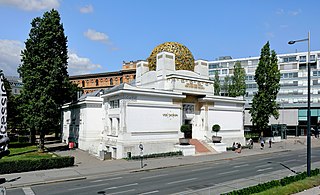
The Secession Building is an exhibition hall in Vienna, Austria. It was completed in 1898 by Joseph Maria Olbrich as an architectural manifesto for the Vienna Secession, a group of rebel artists that seceded from the long-established fine art institution.

Muradxan is a village and municipality in the Kurdamir Rayon of Azerbaijan.

Səfalı is a village in the Shamakhi Rayon of Azerbaijan. The village forms part of the municipality of Dəmirçi.

The Old Town Hall, until 1874 the domicile of the municipality, serves today as a building for representative purposes for the city council in Munich. The Old Town Hall bounds the central square Marienplatz on its east side.

The Hôtel des Monnaies is an 18th-century building located at 11 Quai de Conti in the 6th arrondissement of Paris, which has housed the Monnaie de Paris since its construction. It is considered a prime example of pre-Revolutionary French Neoclassical architecture.

The Old Academy , also called Wilhelminum, is a building in the center of Munich, Germany. Dating from the 16th century, it has a Renaissance facade and four inner courtyards.
Morgan Park is a neighborhood in Baltimore, Maryland located immediately east of Morgan State University.
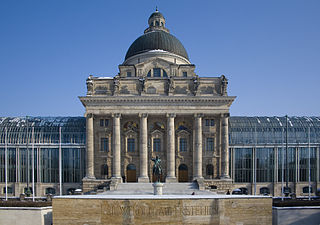
Bayerische Staatskanzlei is the name of a state agency of the German Free State of Bavaria and also of the appendant building.
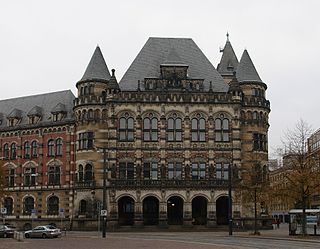
The Landgericht Bremen in the courthouse of the State of Bremen on the Domsheide in the old town of Bremen, Germany. It was built in the late 19th century in the French Renaissance style and completed in 1906. It has been a listed building since 1992. In addition to the judicial services of the regional court, the building houses sections of the Public Prosecutor's department (Staatsanwaltschaft) and of the district court (Amtsgericht).















